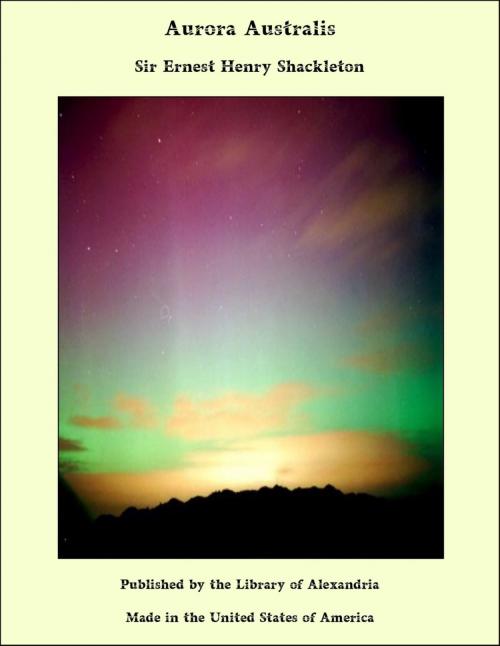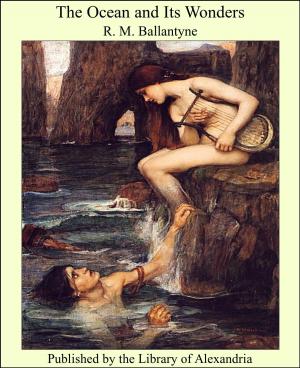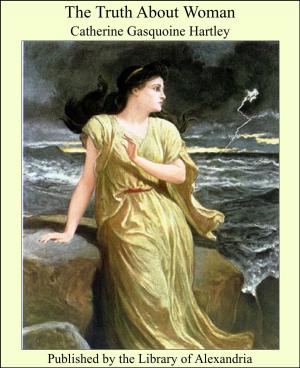| Author: | Sir Ernest Henry Shackleton | ISBN: | 9781465597533 |
| Publisher: | Library of Alexandria | Publication: | March 8, 2015 |
| Imprint: | Language: | English |
| Author: | Sir Ernest Henry Shackleton |
| ISBN: | 9781465597533 |
| Publisher: | Library of Alexandria |
| Publication: | March 8, 2015 |
| Imprint: | |
| Language: | English |
If Ross Island be likened to a castle, flanking that wall the the world's end, The Great Ice Barrier, Erebus is the castle keep. Its flanks and foothills clothed with spotless now, patched with the pale blue of glacier ice, its active crater crowned with a spreading smoke cloud, and overlooking the vast white plain of the Barrier to the East and South, the dark waters of Ross Sea and McMurdo Sound to the North and West, and still further West, the snowy summits of the extinct volcanoes of Victoria Land, Erebus not only commands a view of incomparable grandeur and interest, but is in itself one of the fairest and most majestic sights that Earth can show. Erebus, as seen from our winter quarters, showed distinctly the traces of the three craters, observed from a distance by the British National Antarctic Expedition of 1901 - 04. From sea level up to about 5,500 feet, the lower slopes ascend in a gentle but gradually steepening curve to the base of the first crater. They are largely covered with snow and glacier ice down to the shore, where the ice either breaks off to form a cliff, or, as at Glacier Tongue, spreads out seawards in the form of a narrow blue pier five miles in length: near Cape Rows, however, there are three long smooth ridges of brown glacial gravels and moraines mostly bare of snow. Those are interspersed with masses of black volcanic rock, and extend to an altitude of about 1,000ft. Above this, and up to above 5,000 feet above the sea, all is snow and ice, except of an occasional outcrop of dark lava, or a black parasitic cone, sharply silhouetted agains the light background of snow or sky. At a level of about 6,000 feet, and just north of the second, or main crater, rises a huge black fang of rock, the relic of the oldest and lowest crater. Immediately south of this the principal cone sweeps upwards in that graceful double curve, concave below, convex above, so characteristic of volcanos. Rugged buttresses of dark volcanic rock, with steep snow slopes between, jut out at intervals, and support the rim of this second crater, which reaches an altitude of fully 11,400 feet. From the north edge of this crater the ground seemed to ascend, at first gradually, then somewhat abruptly to the third crater, now active, further south. It is above this last crater that there continually floats a huge steam cloud. At the time of Ross’ Expedition this cloud was reddened with the glow of molten lava, and some thought they saw lava streams descending from the crater. The National Antarctic Expedition had also once or twice witnessed a similar glow, and although, during the few weeks we had been at Cape Royds we had not observed a similar phenomenon, we had at times seen the great steam cloud shoot up suddenly, in the space of a minute or so, to a height of fully 2,000 feet above the mountain top. This sudden uprush was obviously the result of a vast steam explosion in the interior of the volcano, and proved that it still possessed considerable activity.
If Ross Island be likened to a castle, flanking that wall the the world's end, The Great Ice Barrier, Erebus is the castle keep. Its flanks and foothills clothed with spotless now, patched with the pale blue of glacier ice, its active crater crowned with a spreading smoke cloud, and overlooking the vast white plain of the Barrier to the East and South, the dark waters of Ross Sea and McMurdo Sound to the North and West, and still further West, the snowy summits of the extinct volcanoes of Victoria Land, Erebus not only commands a view of incomparable grandeur and interest, but is in itself one of the fairest and most majestic sights that Earth can show. Erebus, as seen from our winter quarters, showed distinctly the traces of the three craters, observed from a distance by the British National Antarctic Expedition of 1901 - 04. From sea level up to about 5,500 feet, the lower slopes ascend in a gentle but gradually steepening curve to the base of the first crater. They are largely covered with snow and glacier ice down to the shore, where the ice either breaks off to form a cliff, or, as at Glacier Tongue, spreads out seawards in the form of a narrow blue pier five miles in length: near Cape Rows, however, there are three long smooth ridges of brown glacial gravels and moraines mostly bare of snow. Those are interspersed with masses of black volcanic rock, and extend to an altitude of about 1,000ft. Above this, and up to above 5,000 feet above the sea, all is snow and ice, except of an occasional outcrop of dark lava, or a black parasitic cone, sharply silhouetted agains the light background of snow or sky. At a level of about 6,000 feet, and just north of the second, or main crater, rises a huge black fang of rock, the relic of the oldest and lowest crater. Immediately south of this the principal cone sweeps upwards in that graceful double curve, concave below, convex above, so characteristic of volcanos. Rugged buttresses of dark volcanic rock, with steep snow slopes between, jut out at intervals, and support the rim of this second crater, which reaches an altitude of fully 11,400 feet. From the north edge of this crater the ground seemed to ascend, at first gradually, then somewhat abruptly to the third crater, now active, further south. It is above this last crater that there continually floats a huge steam cloud. At the time of Ross’ Expedition this cloud was reddened with the glow of molten lava, and some thought they saw lava streams descending from the crater. The National Antarctic Expedition had also once or twice witnessed a similar glow, and although, during the few weeks we had been at Cape Royds we had not observed a similar phenomenon, we had at times seen the great steam cloud shoot up suddenly, in the space of a minute or so, to a height of fully 2,000 feet above the mountain top. This sudden uprush was obviously the result of a vast steam explosion in the interior of the volcano, and proved that it still possessed considerable activity.















